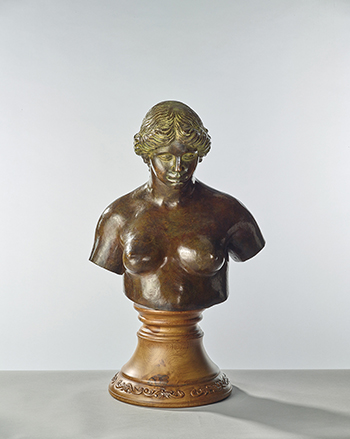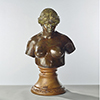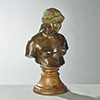EXHIBITED:
Exposition Centaine de l'Impressionisme , Bristol Hotel, Paris, 1974
ILLUSTRATED:
Gilles Néret, Renoir: Painter of Happiness , Taschen GmbH, Cologne, 2002, color illustrated, p. 422
This sculpture is to be sold with a certificate of authenticity by Richard Guino’s son Michel Guino.
Catalogue Note:
A leader amongst Impressionist painters, Renoir was renowned for his portrayal of happy, harmonious scenes. And, under his brush, all the delights of the European bourgeoisie during the mid-tolate 19th century were made eternal. He captured their plump figures, glowing faces, sparkling eyes, and gentle characters. There is only the boundless brilliance of spring, and the dark and dim of winter's gloom is not to be seen. In the artist's later years, he suffered from severe rheumatism. His fingers were bent, and it was impossible for him to paint in the cold of Paris. But he lived for art, so he bound the brush to his hand with a cloth wrap, persisting in his work, and leaving us with a famous saying, ‘La douleur passe, la beauté reste.’
From the 1880s on, the Renoir family often summered at a home that was far removed from the cold. The house of Aline Charigot's niece, Essoyes, sat on the riverside, where women would often wash clothes or play in the water. It was in the middle of the same decade that nude woman started appearing as a subject in paintings. At the end of 1903, the family settled in Cagnes-sur- Mer, near Nice in the South of France, where Renoir remained until his death. According to the artist's second son, renowned director of French naturalist film Jean Renoir, his childhood there was a golden time. It was a peaceful, carefree place lined with women's houses and surrounded by love and affection. The warmth of the Mediterranean sun and sea breeze had found its way into Renoir's heart, and he was inspired to look back on Ancient Greek mythology and classical notions of beauty. With the time that remained for his art, he paid tribute once again to the vitality that woman represents.
In a series of works named after Venus or bathing women and span from 1909 to 1919, Renoir reveals bits and pieces from his unwavering pursuit of the idyllic feminine beauty. Among the women who surrounded the artist were wife, lovers, nannies, maids, and models, all performing the roles of either caretaker or lover, or a live figure in the artist's paintings of paradise. He shed the ostentatious fashions and the scenes from people's social lives that he had depicted in his earlier work. Forced to rely on crutches and a wheelchair to get around, the artist returned to a more heartfelt and pure pursuit of an idyllic world. A record of such a utopia can be found in his paintings. While before it had been possible to pick out who had modelled for Renoir's works, it was not so in later paintings. In those rural scenes, which seem to sing the melodies of mills, there is only the happy nude to be found. Each has similarly bright, fair skin, an endowed figure, and can be seen playing on the riverside as if Nymph from mythology. Renoir's artworks became the classics that they are today for the same reason that the works of his predecessors did. Just like Ingres, Rubens, and Titian, Renoir was able to re-envision and immortalise his own interpretation of the anthropomorphic beauty of Venus.
Even when the rheumatism took over his hands so that he could not sculpt, Renoir still craved for his Venus to break away from the Canvas. He said, “Under this sunlight, I truly want to see Venus cast in marble and bronze beneath the shadow of a silver-leaved olive tree.” In 1913, art dealer Ambroise Vollard introduced him to a man from Catalonia, Spain named Richard Guino, who was the proud apprentice of Renoir's sculptor friend Aristide Maillol. And thanks to Guino's great talent and skill, there was hope of fulfilling Renoir's dream. It was as if their meeting had come fifty years late, the old artist and young sculptor shared such a tacit understanding with each other. Through a simple sketch, a light tapping of his cane, or a gentle nod, Renoir could easily communicate his intentions for the work, even without words. Renoir described this by saying that it was as if at the handle of his cane were a pair of magic hands. Before Renoir passed away in 1919, the two had made models for 37 sculptural works, all completed with Guino's hands and Renoir's mind. In 1973, the French court formally recognised Guino as a co-author of the Renoi sculptural work, granting his descendants a proportion of the profits from the sculpture's inheritance as well as rights to the plaster moulds. A limited edition of Guino's version of the work was also engraved R/G to show the casts were a work the both artists. This result, which was to the common benefit of both families, became a story in art circles for a time.
"Torse de Venus" is a 1915 sculptural work and the only bust of Venus that the artist completed. A large marble version is found in the Renoir Art Museum in the South of France, and the bronze edition has been fought over by collectors around the world. This lot was presented by Richard Guino's son, Michel Gunio, who commissioned the Valsuani Foundry in 1972 to produce this special edition on the first centennial commemoration exhibition of the Impressionisme. It was then authenticated directly by Michel Guino and purchased by Asian collectors. After thirty years of being held in private collections, and still in perfect condition, this is the first time it is appearing on the auction market. This sculpture portrays Venus with an exquisitely detailed, realistic face, with healthy features and gentle eyes. It appears as if it could take a breathe and come to life. Her neck is slender and chest compact, brimming with vitality, although not in a way that would be associated with the famous painting, "Gabriele d'Estrées et une soeur". Madame Renoir's cousin, Gabrielle Renard, who spent 28 years in the artist's home and became a close, indispensable member of the family, is thought to be the model for the prototype of the bust. In Renoir's latter years, she was his favourite model, perhaps projecting his longing for eternal juvenescence.


